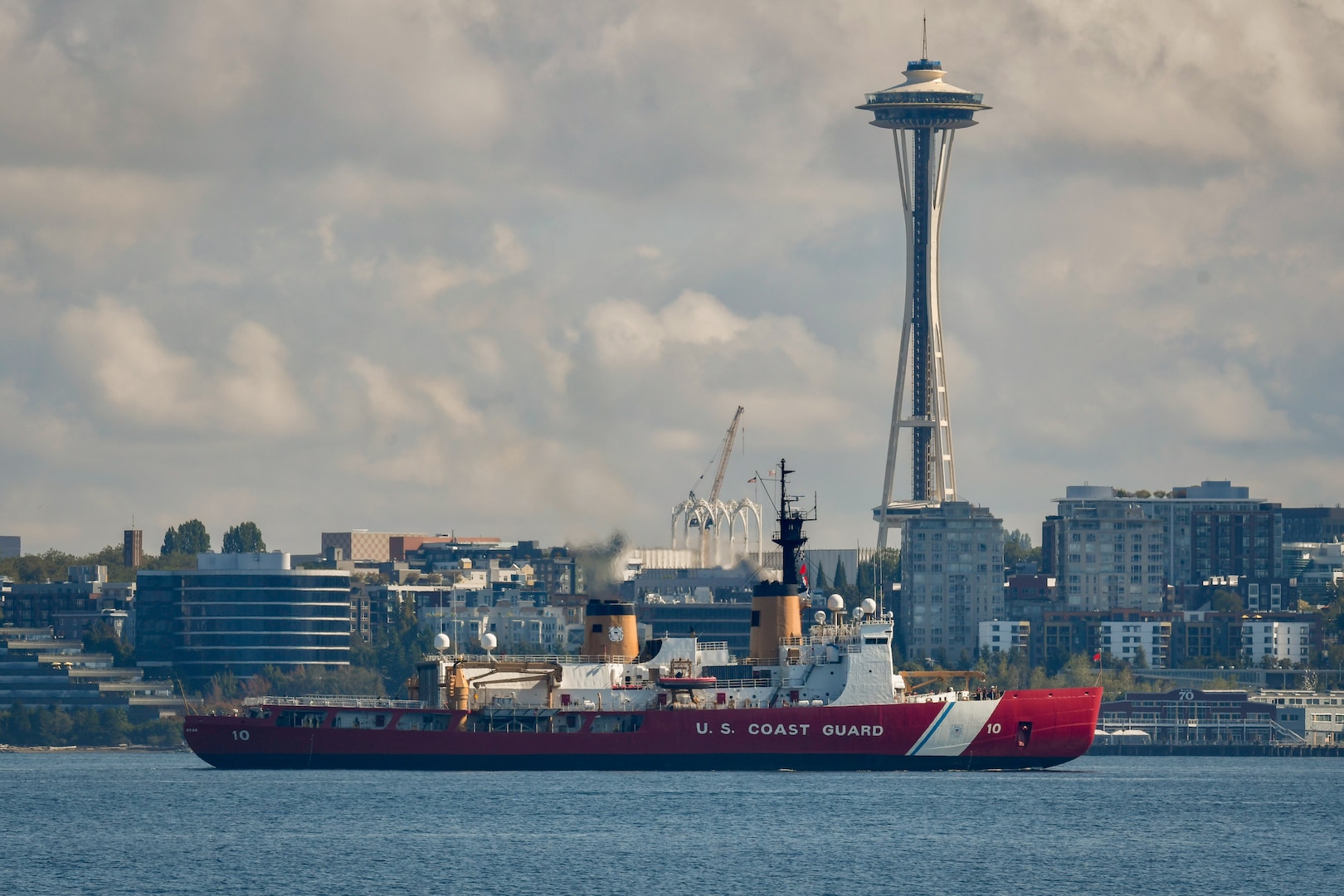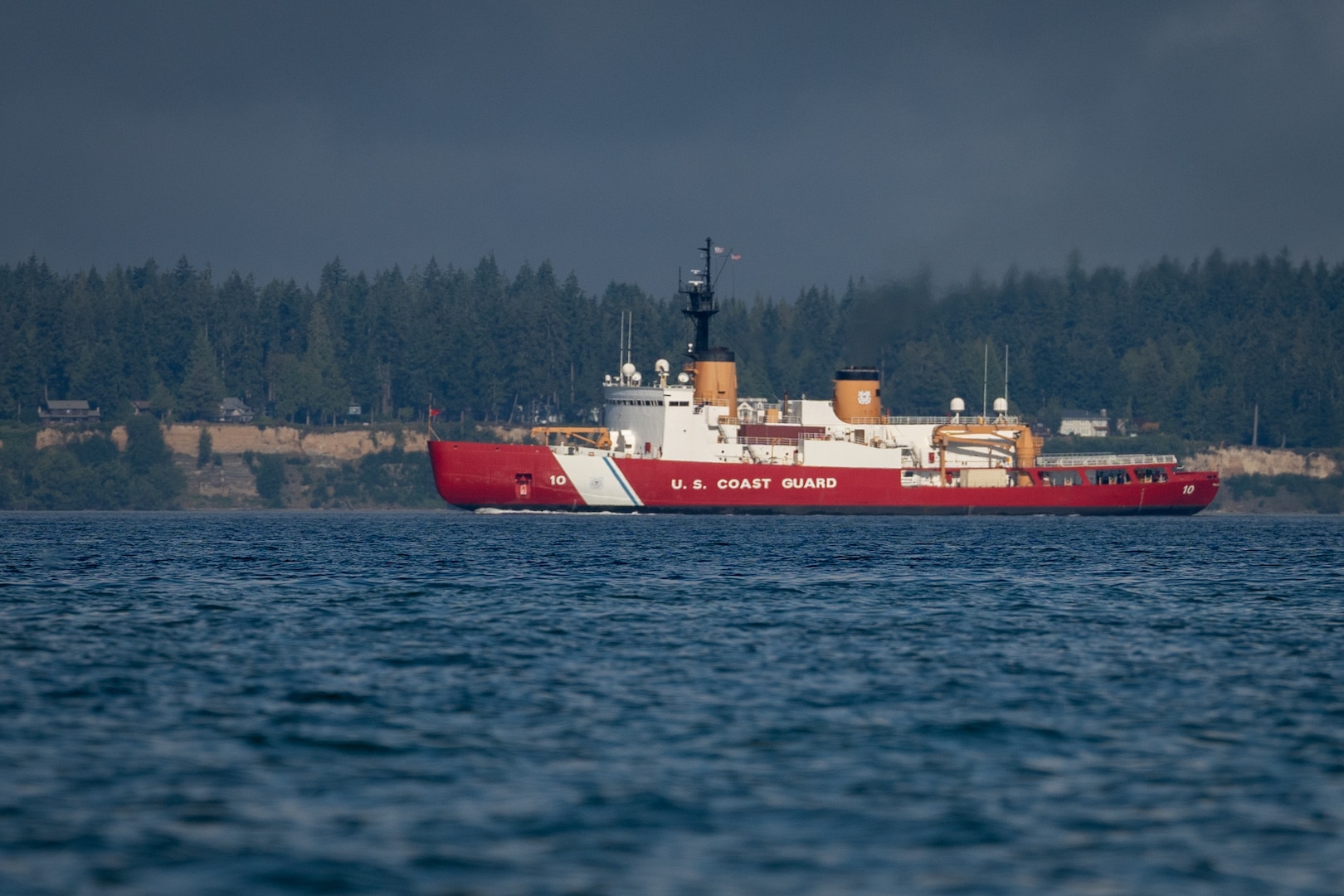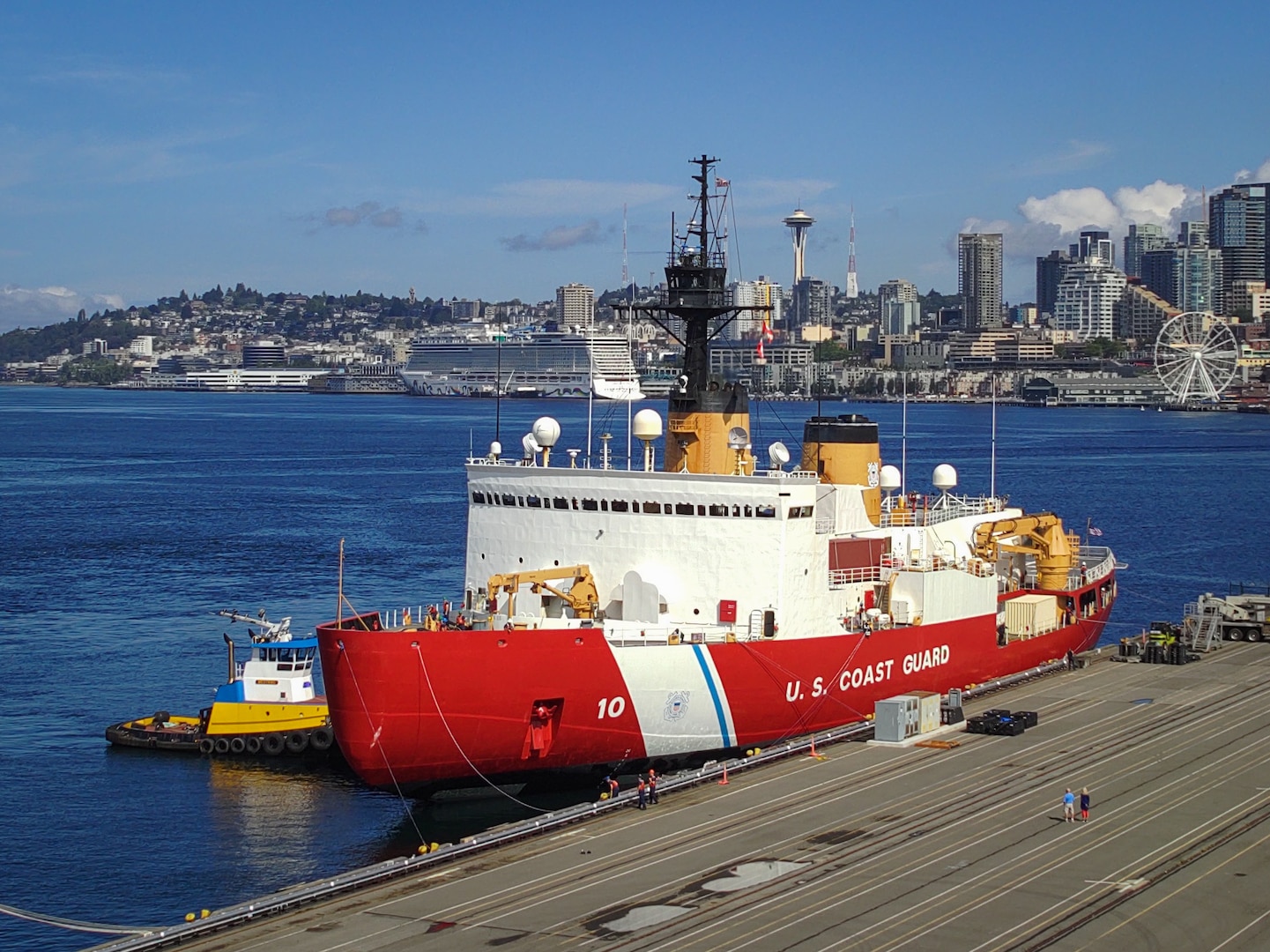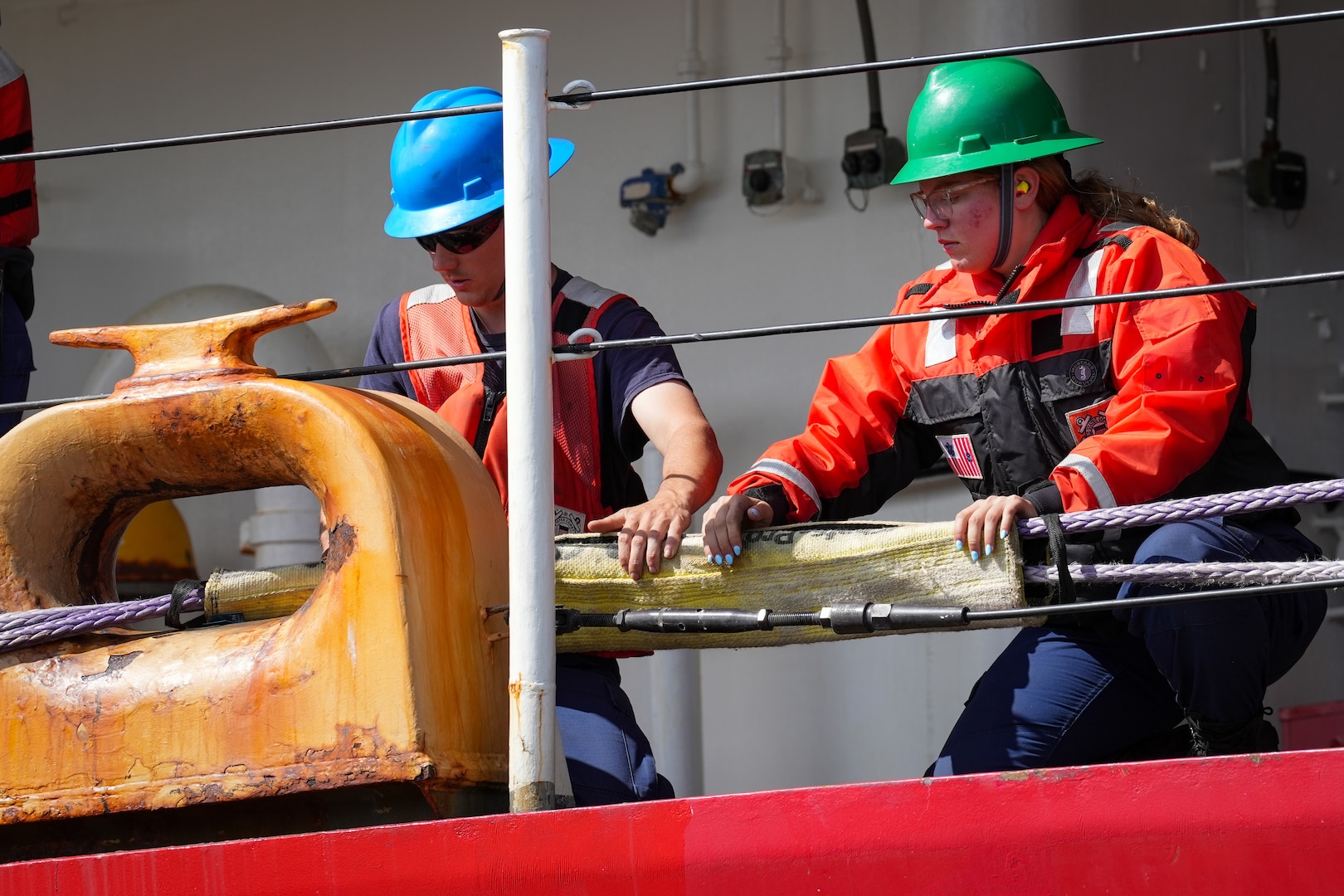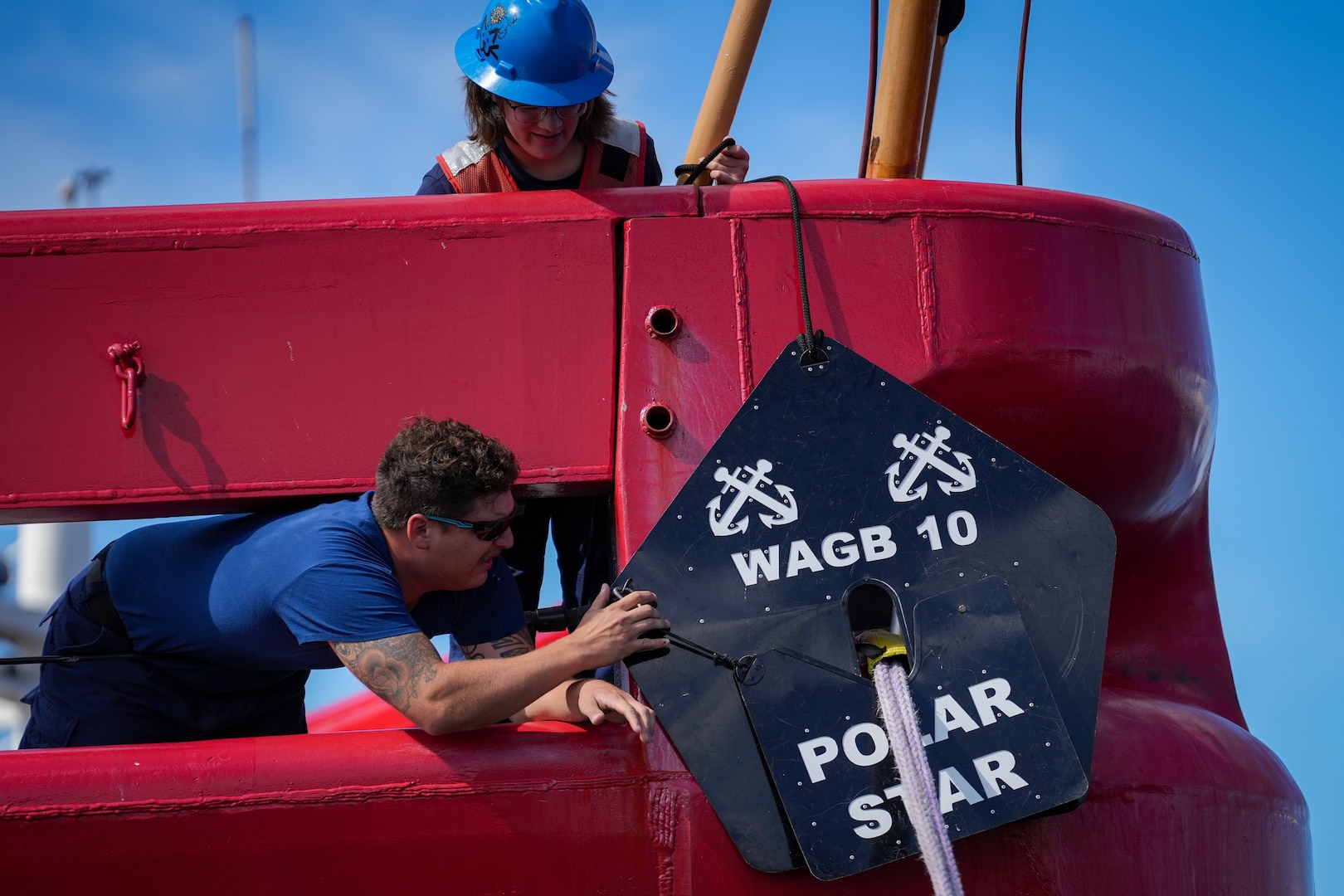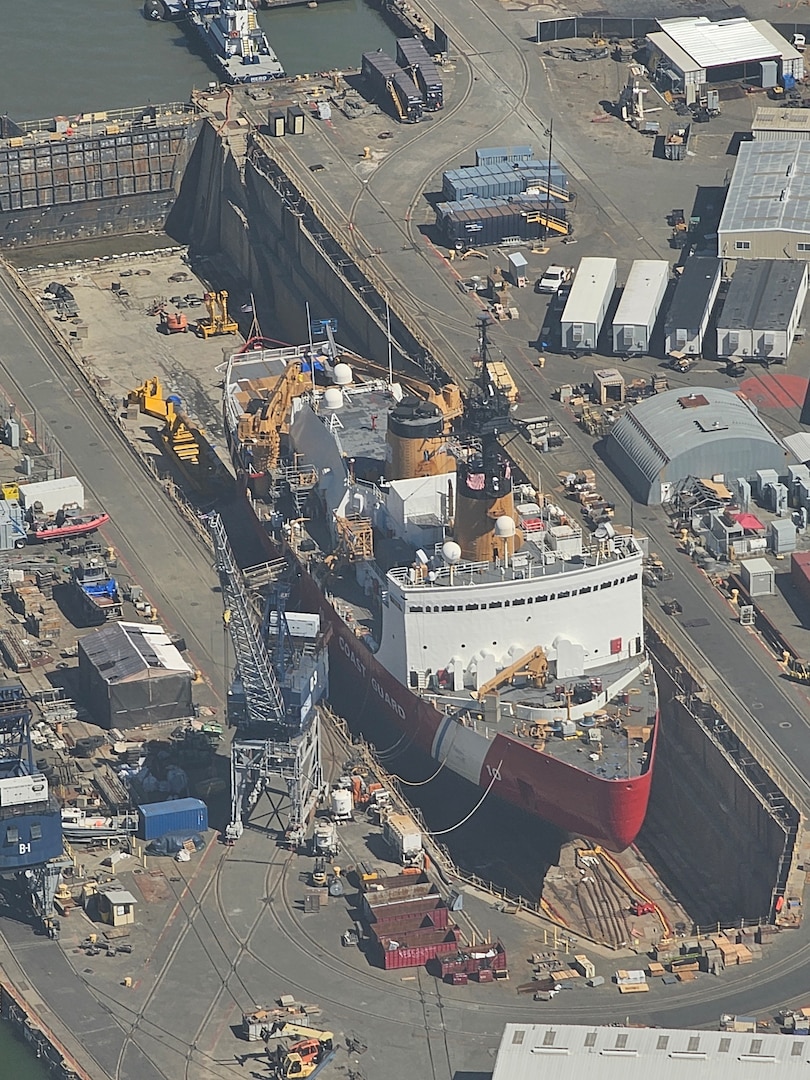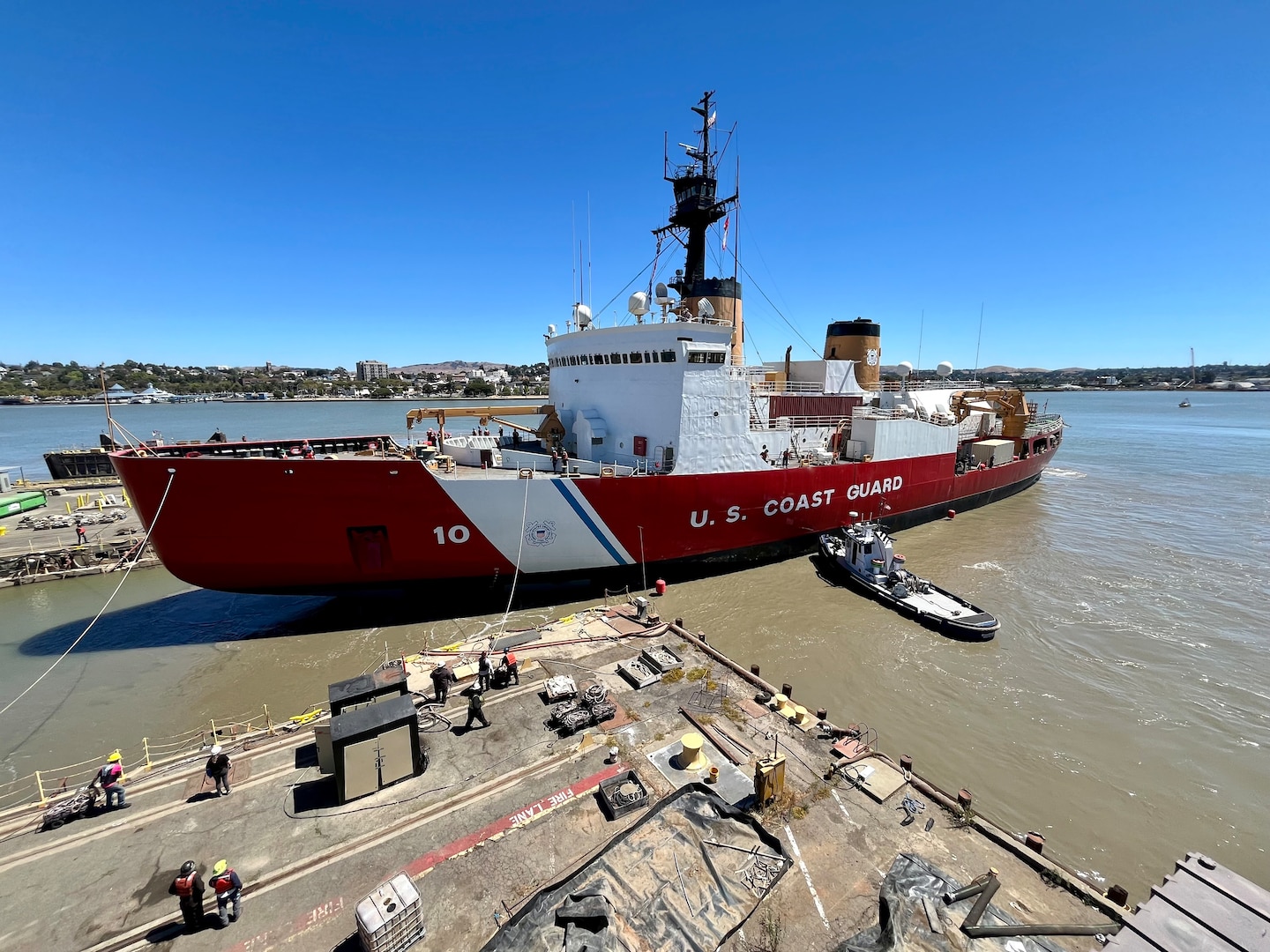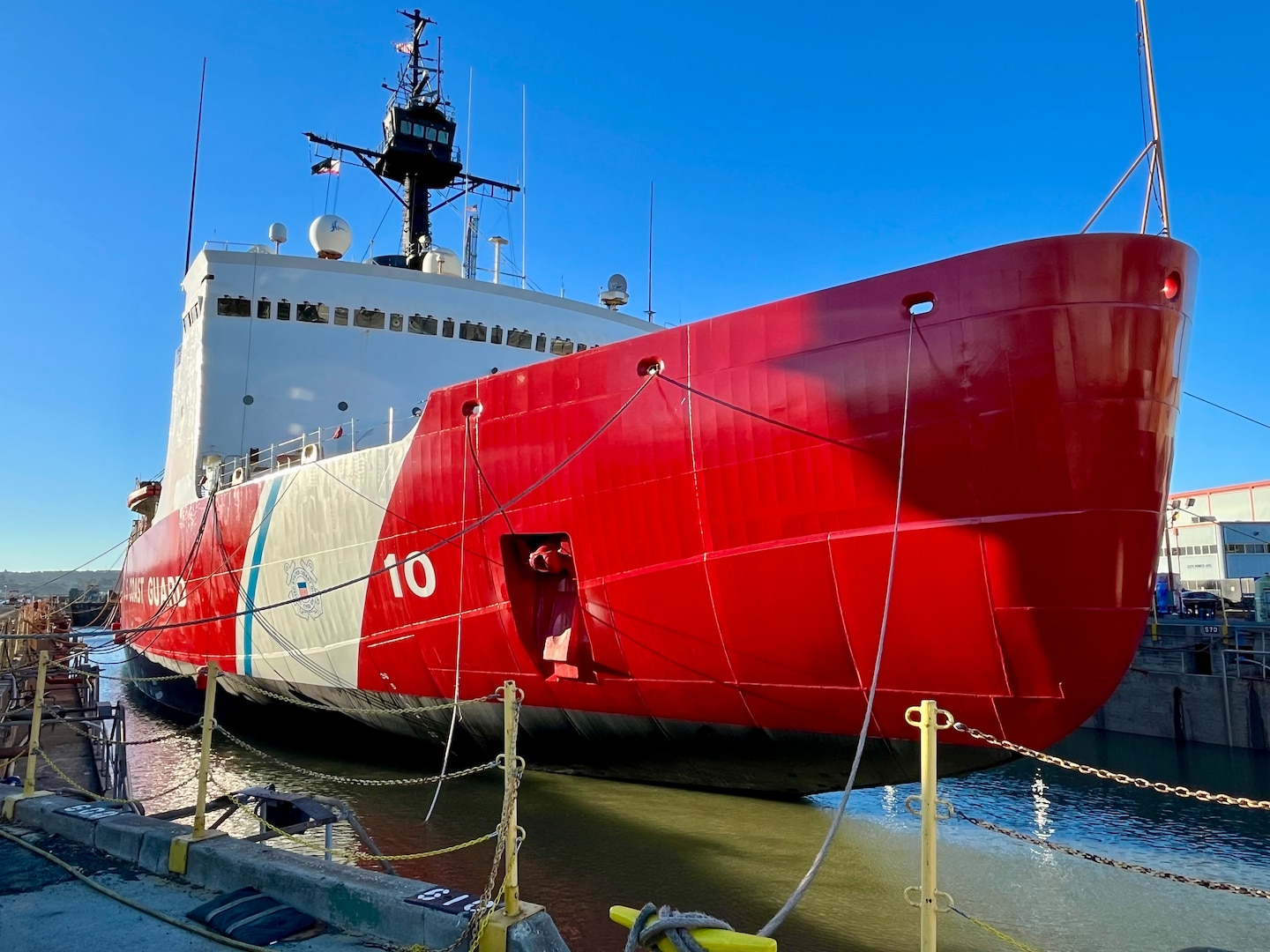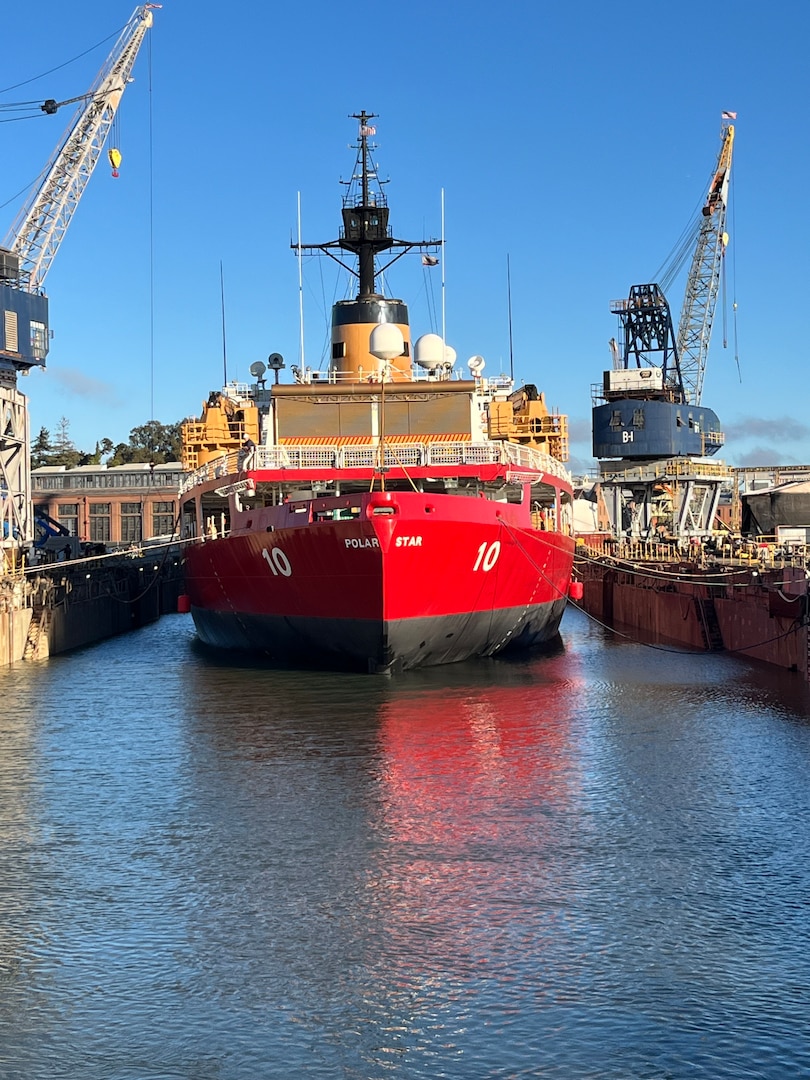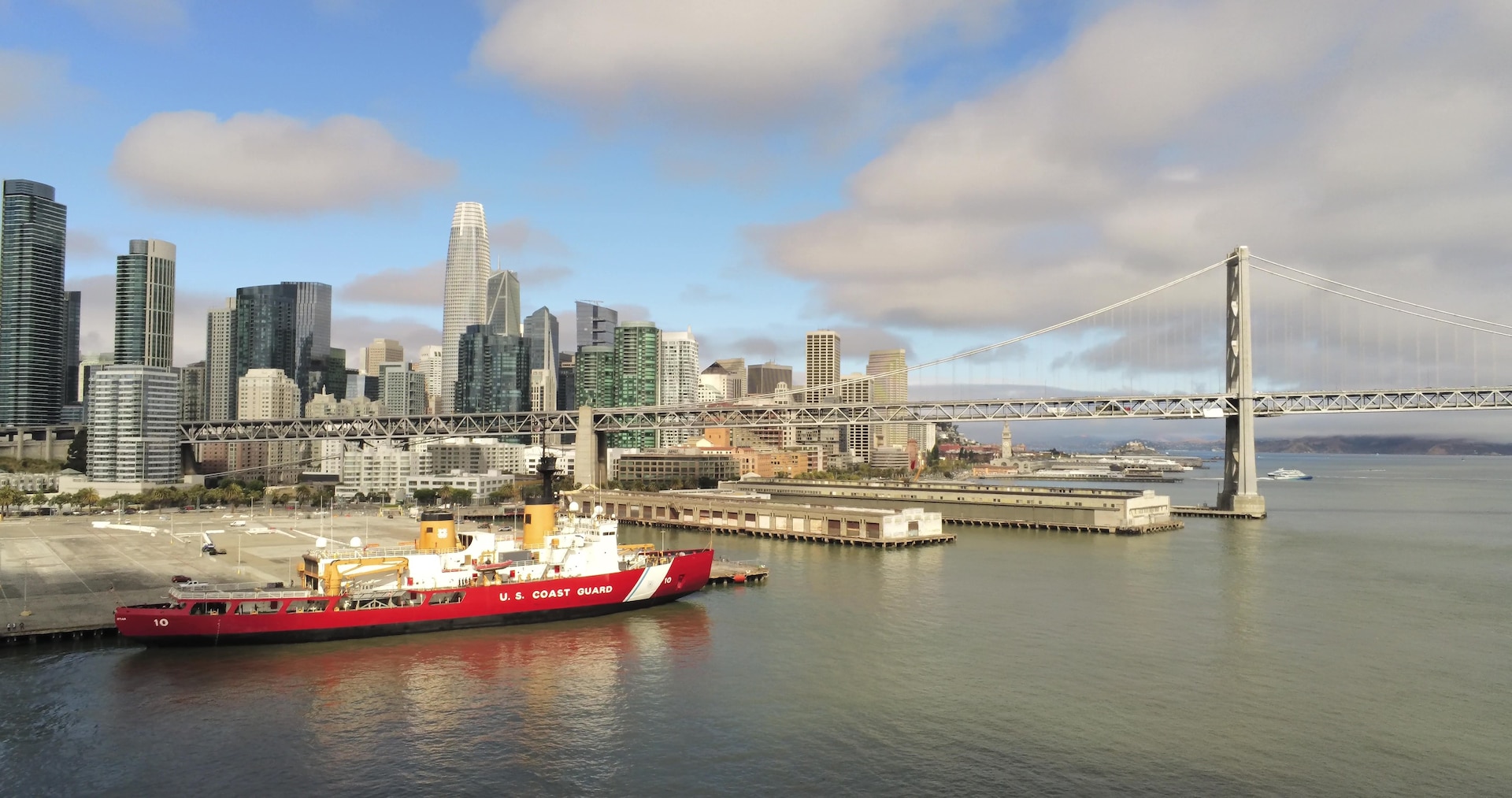240825-G-G0200-1082
U.S. Coast Guard Cutter Polar Star (WAGB 10) transits Elliott Bay near the Seattle waterfront as the cutter approaches its homeport of Coast Guard Base Seattle, Aug. 25, 2024. At a length of 399-feet, the Polar Star is one of the largest cutters in the Coast Guard's fleet. (U.S. Coast Guard photo by Capt. Holly Harrison)
240825-G-SG988-1081
U.S. Coast Guard Cutter Polar Star (WAGB 10) transits Puget Sound near Bainbridge Island, Wash., as the cutter approaches its homeport of Coast Guard Base Seattle, Aug. 25, 2024. The crew returned to their homeport following a several-month dry-dock period in California. (U.S. Coast Guard photo by Petty Officer 2nd Class Steve Strohmaier)
240825-G-SG988-1083
U.S. Coast Guard Cutter Polar Star (WAGB 10) is pushed by assist tugboats into a pier at Coast Guard Base Seattle, Aug. 25, 2024. The crew returned to their homeport following a several-month dry-dock period in California. (U.S. Coast Guard photo by Lt. Chris Butters)
240825-G-SG988-1089
U.S. Coast Guard Cutter Polar Star (WAGB 10) (left) sits moored next to U.S. Coast Guard Cutter Healy (WAGB 20) at Coast Guard Base Seattle, Aug. 25, 2024. The Polar Star and Healy are routinely deployed to Arctic and Antarctic locations to support science research or help resupply remote stations. (U.S. Coast Guard photo by Lt. Chris Butters)
240825-G-SG988-1088
Crew members from U.S. Coast Guard Cutter Polar Star (WAGB 10) apply chafing gear to one of the lines after the cutter arrived at its homeport of Coast Guard Base Seattle, Aug. 25, 2024. The Polar Star is the only active heavy-duty icebreaker in the Coast Guard's fleet. (U.S. Coast Guard photo by Petty Officer 2nd Class Steve Strohmaier)
240825-G-SG988-1084
A crew member from U.S. Coast Guard Cutter Polar Star (WAGB 10) fastens a rat guard to a stern line after the cutter arrived to its homeport of Coast Guard Base Seattle, Aug. 25, 2024. The cutter is slated to remain in Seattle until beginning their Operation Deep Freeze deployment later in the year. (U.S. Coast Guard photo by Petty Officer 2nd Class Steve Strohmaier)
Coast Guard Cutter completes fourth phase of a five-year Service Life Extension Project
The U.S. Coast Guard Cutter Polar Star (WAGB 10) undergoes the fourth phase of a five-year Service Life Extension Project at the Mare Island Dry Dock, LLC. in Vallejo, California, June 23, 2024. The work completed was part of the in-service vessel sustainment program with the goal of recapitalizing targeted systems, including propulsion, communication, and machinery control systems, as well as effecting significant maintenance to extend the cutter’s service life. U.S. Coast Guard photo by Cdr. Jeremy Courtade.
Coast Guard cutter completes fourth phase of a five-year Service Life Extension Project
The U.S. Coast Guard Cutter Polar Star (WAGB 10) undergoes the fourth phase of a five-year Service Life Extension Project at the Mare Island Dry Dock, LLC. in Vallejo, California, June 23, 2024. The work completed was part of the in-service vessel sustainment program with the goal of recapitalizing targeted systems, including propulsion, communication, and machinery control systems, as well as effecting significant maintenance to extend the cutter’s service life. U.S. Coast Guard photo by Cdr. Jeremy Courtade.
Coast Guard Cutter completes fourth phase of a five-year Service Life Extension Project
The U.S. Coast Guard Cutter Polar Star (WAGB 10) is backed out of a dry dock facility in Vallejo, California, after the cutter underwent maintenance, Aug. 15, 2024.The months-long maintenance was part of the in-service vessel sustainment program with the goal of recapitalizing targeted systems, including propulsion, communication, and machinery control systems, as well as effecting significant maintenance to extend the cutter’s service life. U.S. Coast Guard photo by Lt. Megan Rice.
Coast Guard Cutter completes fourth phase of a five-year Service Life Extension Project
The U.S. Coast Guard Cutter Polar Star (WAGB 10) is refloated within a dry dock facility in Vallejo, California, after the cutter underwent months-long maintenance, Aug. 15, 2024. The cutter completed phase four of Polar Star’s Service Life Extension Project which took place over approximately 140 days and represented a total investment of $16.8 million. U.S. Coast Guard photo by Lt. Megan Rice.
Coast Guard Cutter completes fourth phase of a five-year Service Life Extension Project
The U.S. Coast Guard Cutter Polar Star (WAGB 10) is refloated within a dry dock facility in Vallejo, California, after the cutter underwent maintenance, Aug. 15, 2024. The cutter completed phase four of Polar Star’s Service Life Extension Project which took place over approximately 140 days and represented a total investment of $16.8 million. U.S. Coast Guard photo by Lt. Megan Rice.
Coast Guard Cutter completes fourth phase of a five-year Service Life Extension Project
The U.S. Coast Guard Cutter Polar Star (WAGB 10) is moored in San Francisco following the fourth phase of a five-year Service Life Extension Project at the Mare Island Dry Dock, LLC. in Vallejo, California, Aug. 18, 2024. The work completed was part of the in-service vessel sustainment program with the goal of recapitalizing targeted systems, including propulsion, communication, and machinery control systems, as well as effecting significant maintenance to extend the cutter’s service life. U.S. Coast Guard photo by Petty Officer 2nd Class Jeremy Burgess.
Coast Guard cutter departs San Francisco after completion of fourth phase of a five-year Service Life Extension Project
The U.S. Coast Guard Cutter Polar Star (WAGB 10) sails under the Golden Gate Bridge after it departed the San Francisco Bay Area following scheduled maintenance in Vallejo, Calif. en route to the cutter’s homeport of Seattle, Aug. 22, 2024. The Polar Star is a 399-foot heavy polar icebreaker commissioned in 1976; the six diesel and three gas turbine engines produce up to 75,000 horsepower. (U.S. Coast Guard photo by Auxiliarist Pablo Fernicola)
/ Published Aug. 28, 2024
SEATTLE — The U.S. Coast Guard Cutter Polar Star (WAGB 10) and crew returned to Seattle, Sunday, after 285 days away from the cutter’s home port.
Following a 138-day deployment to Antarctica supporting Operation Deep Freeze 2024, the Polar Star reported directly to Mare Island Dry Dock (MIDD) LLC. in Vallejo, California, to commence the fourth phase of a five-year Service Life Extension Project (SLEP).
The work completed at MIDD is part of the in-service vessel sustainment program with the goal of recapitalizing targeted systems, including propulsion, communication, and machinery control systems, as well as effecting significant maintenance to extend the cutter’s service life.
Polar Star’s SLEP work is completed in phases to coordinate operational commitments such as the cutter’s annual Antarctic deployment. Phase four began on April 1, 2024, targeting three systems:
- Boiler support systems were recapitalized, including the electrical control station that operates them.
- The heating, ventilation and air conditioning (HVAC) system was refurbished through the overhaul of ventilation trunks, fans and heaters that supply the cutter’s berthing areas.
- The flooding alarm system was redesigned, providing the ability to monitor machinery spaces for flooding from bow to stern.
Additional work not typically completed every dry dock included removing and installing the starboard propulsion shaft, servicing and inspecting both anchor windlasses, inspecting and repairing anchor chains and ground tackle, cleaning and inspecting all main propulsion motors and generators, installation of an isolation valve to prevent seawater intrusion into the sanitary system, and overhauling the fuel oil purifier.
Phase four of Polar Star’s SLEP took place over approximately 140 days and represented a total investment of $16.8 million. By replacing outdated and maintenance-intensive equipment, the Coast Guard will mitigate lost mission days caused by system failures and unplanned repairs. The contracted SLEP work items and recurring maintenance is taking place within a five-year, annually phased production schedule running from 2021 through 2025.
The Coast Guard is investing in a new fleet of polar security cutters (PSC) that will sustain the service’s capabilities to meet mission needs in both the Arctic and Antarctic regions. The SLEP allows Polar Star to continue providing access to the Polar regions until the PSCs are operational and assume the high latitude missions. Polar security cutters will enable the U.S. to maintain defense readiness in the Polar regions; enforce treaties and other laws needed to safeguard both industry and the environment; provide ports, waterways and coastal security; and provide logistical support – including vessel escort – to facilitate the movement of goods and personnel necessary to support scientific research, commerce, national security activities and maritime safety.
“Completing a dry dock availability is a positive milestone, and despite challenges due to being away from home port, our crew’s energy and resilience inspires me every day,” said Capt. Jeff Rasnake, Polar Star’s commanding officer. “The amount of time and effort put into Polar Star and its mission is truly remarkable. The dedication and teamwork displayed across all stakeholders exemplifies the Coast Guard’s flexibility and commitment to ensuring the continued success of Operation Deep Freeze as well as strengthened partnerships among nations invested in the Antarctic latitudes. I look forward to observing how this crew will continue to grow as a team and to discovering what we can accomplish together.”
Along with the rigorous maintenance schedule, Polar Star held a change of command ceremony on July 8, 2024, in Vallejo, where Rasnake relieved Capt. Keith Ropella as the cutter’s commanding officer. Rasnake served as the deputy director for financial management procurement services modernization and previously served as Polar Star’s executive officer. Ropella transferred to the office of cutter forces where he will oversee the management of the operational requirements for the cutter fleet and develop solutions for emerging challenges facing the afloat community.
Polar Star is the Coast Guard’s only active heavy polar icebreaker and is the United States’ only asset capable of providing year-round access to both polar regions.
Commissioned in 1976, the cutter is 399 feet, weighing 13,500 tons with a 34-foot draft. Despite reaching nearly 50 years of age, Polar Star remains the world’s most powerful non-nuclear icebreaker with the ability to produce up to 75,000 horsepower. Polar Star’s SLEP is important to the survival of the Antarctic mission and crucial to the well-being and success of Polar Star and crew during these long missions.
###

